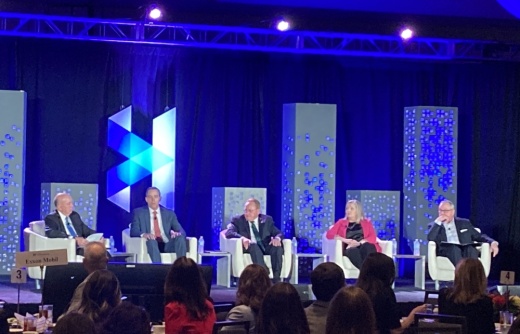County Judge Mark Keough; Gil Staley, CEO of The Woodlands Area Economic Development Partnership; Jim Carman, president of the Houston region of The Howard Hughes Corp.; and Danielle Scheiner, executive director of the Conroe Economic Development Council, formed a discussion panel at the event moderated by Stephen Head, chancellor of Lone Star College System.
Katie Pryor, chief development officer and senior vice president for member engagement with the GHP, said in the past decade the population in Montgomery County has grown by 37% to nearly 650,000 residents. It also has recently seen several out-of-state companies decide to move their headquarters to The Woodlands with California-based Cellipont Bioservices planning to move to the Research Forest area and biopharmaceutical manufacturer VGXI moving to Conroe's Deison Technology Park from The Woodlands this year.
"The rising economic development interests in the area, particularly in Montgomery County, recently have created incredible opportunities for innovation and growth in sectors and industries and technology, which are vital to the continued growth of the Greater Houston region as a whole," she said.
Panel members discussed topics such as the region's diversity in offerings for both residents and businesses.
"It's kind of unique that you can have an area like The Woodlands, it's such an attractor for corporate in regional headquarter locations, coupled with ... having Conroe which is an excellent location for a manufacturing plant, [and] the county's airport, which is located in Conroe, with the tower and the runway expansion ... has allowed us to attract a lot of corporate aircraft into the community," Scheiner said.
She further said building and housing starts have been up since changes took place in the market during COVID-19.
"We had an increase of about 80% on building ... housing starts during COVID[-19]. ... And then in 2021, we had an increase on top of that COVID number. So it's been remarkable."
Staley also said he is seeing recovery following the COVID-19 pandemic.
"Our business recruitment [requests for proposals] are above prepandemic levels. ... We're seeing retail sales coming back very strong, double-digit sales year over year. I know The Woodlands Township's reporting their numbers up; Oak Ridge North is doing the same as well as Shenandoah," Staley said.
Carman said there is increasing diversity in the types of businesses locating in the region as well.
"I think what might be interesting to folks is how diverse our tenant base ... our industries have become over the last several years particularly. We signed this year almost almost 400,000 square feet of leases. ... [And] only about 20%-25% are in oil and gas. Most most of them are in professional services. We have alternative energy; we have utilities, infrastructure; we got a really interesting company that just relocated to us from California, Obagi, a cosmetics company, and they relocated for all those reasons that that we're talking about today—a low-tax environment ... that is pro-growth."
Regarding changes in the workforce that have taken place since 2020, Keough pointed to the county's efforts to move toward reopening after shutdowns that occurred during the early days of COVID-19.
"We as a county have taken the position it's time to come back to work," Keough said. "Decisions are made quicker; conclusions are drawn faster [in person]. When people are in the same room around the same table talking to each other, I think it's better for business."
He said going forward, infrastructure will be key to keeping up with growth.
"The biggest issue is infrastructure to manage this growth," Keough said. "We as a county have come up with the countywide mobility plan. ... We have so much in, but we must continue this spread of infrastructure to be able to accommodate it. Otherwise, it's just going to bog down."





